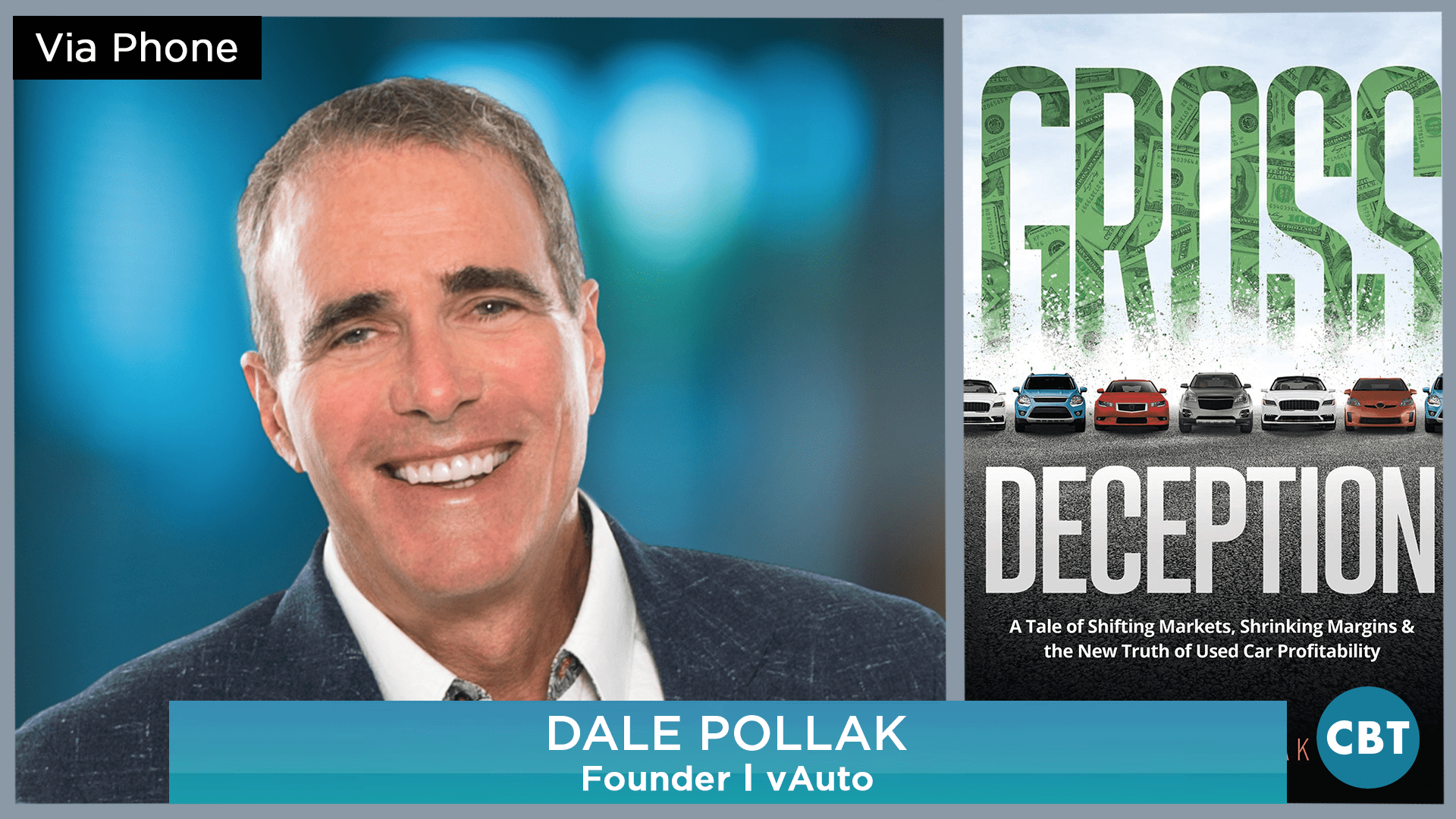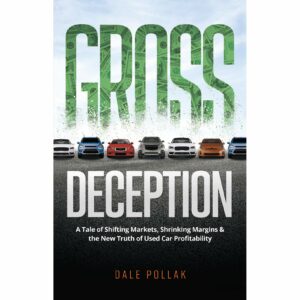On today’s show, we’re pleased to welcome Dale Pollak, Founder of vAuto and Executive Vice President for Cox Automotive, back to CBT News. Dale is no stranger to CBT, and today we are eager to discuss his brand new book “Gross Deception: A Tale of Shifting Markets, Shrinking Margins and the New Truth of Used Car Profitability.” We’ll also hear Dale’s take on the used vehicle and inventory trends should dealers keep an eye on in 2020. Don’t forget to swing by vAuto’s booth #2316C at this year’s NADA Show.
Jim Fitzpatrick: Hi, everyone. Jim Fitzpatrick for CBT News. Thanks so much for joining us today. Today, we’ve got a special guest with us, Mr. Dale Pollak. I know that you know that name in the industry if you’ve been in the industry for any longer than about a day. He is the Founder of vAuto and Executive Vice President for Cox Automotive. Dale, welcome into the show.
Dale Pollak: Thanks, Jim. Great to be with you again.
Jim Fitzpatrick: Sure. Congratulations on your fifth book, Gross Deception: A Tale of Shifting Markets, Shrinking Margins, and the New Truth of Used Car Profitability. What can you tell us about that book? What would you like your readers to walk away with?
Dale Pollak: The book chronicles an event that occurred in the spring of 2016 that truly was a watershed moment in the history of the used car business. It created a shift in the market that has profound implications for dealers today and into the future. What’s really interesting, Jim, is that virtually nobody noticed what had happened. We can fairly closely pinpoint it almost to the month, in the spring of 2016 that this occurred. The book reveals what happened in the spring of 2016, but more importantly, the implications, and ultimately, new strategies for dealers to be profitable in this new market of shrinking margins and really tough times.
Jim Fitzpatrick: Sure. What events specifically in 2016 are you referring to?
Dale Pollak: Well, you’re going to have to get the book to see, but I will give you a little primer about it. Essentially what happened is the margin compression that everyone knew had been occurring for a reason that we did not understand at the time we detected it took a sudden jump, a sudden acceleration, due to a confluence of events that occurred in the spring of 2016 that literally created a new used car marketplace.
Jim Fitzpatrick: Sure. What are some of the key takeaways from your book that dealers should consider leveraging for their own business?
Dale Pollak: Well, one of the primary takeaways, as counterintuitive as it may seem, is that it refutes a very common notion on the part of dealers that more volume equals greater profitability-
Jim Fitzpatrick: Right.
Dale Pollak: And the reality is is that no longer does volume necessarily equate to profitability. It could, but in many cases it will not.
Jim Fitzpatrick: It’s really more of a quality deal rather than a quantity situation? Higher grosses-
Dale Pollak: Well-
Jim Fitzpatrick: On lesser units?
Dale Pollak: Yes. Dealers need to do volume, but they need to do volume intelligently, and doing volume intelligently requires some very, very difficult and challenging shifts in used vehicle management strategy.
Jim Fitzpatrick: Yeah, for sure. What used vehicle and inventory trends should dealers keep their eye on in 2020 in your opinion?
Dale Pollak: Well, what they need to understand is what’s happening on the bottom line, the net profit line of their used vehicle department. It’s very interesting, Jim, that if you ask most any dealer how many used vehicles they sold last month, they know. If you ask them what their average gross was, they can tell you right off the cuff.
Jim Fitzpatrick: Right.
Dale Pollak: Ask a dealer what the net profit of their used vehicle department was last month or last year, and chances are that they don’t know or mostly look. Here’s the really stunning fact. The stunning fact is that roughly half the dealers in America have a net loss for the year 2019 in their used vehicle department. Let me tell you about the other half that have a profit. Almost all of those that did make a profit, if you compared 2019’s net profit to the net profit of the prior three years, in almost all cases, it’s trending down to zero.
Dale Pollak: Now, this is what’s happening in spite of the fact that our industry is experiencing record or near-record volume levels of used car sales. In an environment where we’re selling more cars than ever, half the dealers are losing money on a net basis, and the other half are trending down to zero. You have to know something changed. You have to know something is wrong, and fortunately, we know what it is, and more importantly, we know exactly what to do about it. That’s what we write about in the book.
Jim Fitzpatrick: Sure. Can you share with us a couple of the top points that you point to as contributing factors in this?
Dale Pollak: I make two prescriptions for dealers to reverse the negative trend and increase profitability, and I write about these two prescriptions in the book. One is what I call balancing the equation, and the second is taking a different approach to managing vehicles, and that different approach says, “Let’s no longer manage inventory and let’s begin to manage investments.” In other words, taking an investment-minded approach to used vehicle management.
Dale Pollak: Now, I’ll tell you, Jim, that both of these prescriptions are very, very challenging for dealers because it calls for a change in thinking and behavior that in many respects is 180 degrees opposite of every bit of past experience training that they’ve had. It is, in fact, the prescription for better outcomes. It is, in fact, something that I know that all dealers will eventually come around to, but nevertheless, it is a challenging way forward.
Jim Fitzpatrick: You know, with this bit of information here that you’re sharing today, and obviously a number of dealers know this as well, but with the margin compression on the front end of new car deals that we’ve been suffering with for some time now and now the notion that we’re going to be possibly losing money, not just possibly, but losing money on used cars, that’s kind of a grim outlook. This should be a front page headline story in your opinion, right?
Dale Pollak: Yes it should, and it’s not just a grim outlook, it’s a grim reality.
Jim Fitzpatrick: Right, right.
Dale Pollak: According to NADA, for the past several years, roughly half the dealers are negative debt, the other half that are positive are trending down, but again, in spite of record volume. It is challenged, the marketplace is extremely challenged, but there is some hope here. The hope is… Well, it’s more than hope. There is a better way forward, but it’s different than what we’ve done in the past.
Dale Pollak: It’s different than what I’ve espoused in the past, and when it’s done and it has been proven and this is what I write about in the book with actual referenceable dealer experiences, it can change and make reversals in the trends that are dramatic. I mean, to the tune of 60, 70, 80% reversal and in terms of improved profitability, and nothing, nothing creates improvement in our industry like that today unless you have solved for some very fundamental problems. That’s what these dealers have done that I’ve written about.
Jim Fitzpatrick: Yeah, that’s for sure. How can dealers apply the learnings from your book to capitalize on these trends?
Dale Pollak: In order to change strategy, and particularly when that change is very challenging, a dealer must understand what I refer to as the why. If any of us are going to do anything different particularly when it’s hard, we better understand why we need to do that. The answer to that begins with them understanding analysis and recognition of what’s happening with the net profit bottom line of their used vehicle department. Once they understand that what they’re doing today isn’t working, or if it is working. it’s not working as well as it once did in the past, that leads to the next inevitable question, and that is, “What should I be doing differently?”
Dale Pollak: I wrote the book, Jim, to begin the process of enlightenment, thinking, and discussion among dealers. I will tell you that most dealers today are actually not prepared to make the type of change that these dealers I’ve written about have done. Some are, but most are not. Perhaps they should not try until and unless they fully understand what the current problem is, what the solutions are, and ready themselves and their organization for what really is some profound paradigm-changing strategy management.
Jim Fitzpatrick: Sure, and to be committed to it overall. It sounds like it’s not something to just try on for size in a month or two, right?
Dale Pollak: Correct. It requires a full-throated commitment.
Jim Fitzpatrick: Right. A complete different way to look at your business overall. We sat down with Jonathan Smoke yesterday and his prediction for the SAAR for 2020 coming off of a 17 million-plus SAAR for 2019 was about 16.6. He said new car sales will drop a little bit, but used car sales will increase. First, what’s your take on that? Second of all, it sounds to me like there’s no time better to focus on your used car profitability than right now.
Dale Pollak: Correct, and I’d like to make just a couple of points about Jonathan Smoke’s and others’ predictions of SAAR. I think it’s really important for dealers to understand that the total SAAR is relatively meaningless to dealers. What is very meaningful to dealers is not the total SAAR but the retail portion of the SAAR-
Jim Fitzpatrick: Right.
Dale Pollak: Because the commercial and fleet portion is essentially inconsequential to most every dealer.
Jim Fitzpatrick: That’s right.
Dale Pollak: Last year, by best estimate, the retail SAAR, the number that actually matters to dealers, is roughly about 13.5 million. That’s the number that dealers should keep their eye on. That’s the number that they ultimately should care about. Now, with respect to what is anticipated for used vehicle sales in 2020, I think we’re going to have a very good volume year, and I think that’s largely going to be driven by two factors.
Dale Pollak: Number one, the affordability problem of new vehicles, and number two, the tailwinds of low interest rates, but, and here is the real important but, Jim, volume no longer assures in any way, shape, or form dealers’ profitability. While we see some brightness potentially in the forecast for used vehicle volume in the coming year, it should not necessarily be assumed that means profitable outcomes for dealers unless they fundamentally change their strategy of management.
Jim Fitzpatrick: Right. Let’s switch gears a little bit and talk about what your opinion is… We’re here now in election year. Do you think that will have an impact on new car sales or used car sales, the auto industry as a whole?
Dale Pollak: To the extent that I’m aware, I think election years have been pretty decent years for car sales, but of course, there’s variables that often we cannot anticipate. I think that the year that we’re in now will generally bring relatively robust volumes, but again, what the real plea is, does that necessarily translate into profitable outcomes? It just simply doesn’t automatically mean that anymore. It once did but no more. It’ll be an interesting year for sure. The political landscape is very dynamic and I think we’re going to be in for a ride, but I anticipate the used car buy-in [inaudible 00:12:39] going to be fairly strong. What happens in terms of net outcomes I think is very much in the hands of dealers themselves.
Jim Fitzpatrick: Sure, so now is the best time for dealers to get their house in order with regard to gross profit in the used car department, right?
Dale Pollak: To be sure, and ultimately, the focus should be on net profit, and that’s one of the points that I make in Gross Deception.
Jim Fitzpatrick: Sure, sure. I won’t take up too much of your time. Talk to us a little bit about NADA that’s coming up in just the next three weeks. I’m sure we’ll see out there is that it’ll be… How many NADAs have you attended now?
Dale Pollak: Well, this will be my 51st, and somebody told me you just need to stop counting after 50, so I guess I may take that advice-
Jim Fitzpatrick: 51 NADAs [crosstalk 00:13:24]-
Dale Pollak: But suffice it to say, I’ve… I’m sorry?
Jim Fitzpatrick: I say 51 NADAs. I can barely get through just one and I’m exhausted, just the thought of it.
Dale Pollak: 51 NADAs.
Jim Fitzpatrick: Wow.
Dale Pollak: I’ve seen a lot, but you know what’s really interesting, Jim? Is although I’ve seen 51, they still excite me.
Jim Fitzpatrick: Yeah.
Dale Pollak: They still are something that I look forward to because every year you go there and you learn.
Jim Fitzpatrick: That’s right.
Dale Pollak: I think learning is a lot of fun and that’s what I really enjoy. I’m looking forward to being there in a couple of weeks in Las Vegas and seeing a lot of old friends and meeting new ones and seeing what’s new on the horizon. It’s always fascinating.
Jim Fitzpatrick: Sure, absolutely. Well, I’m sure you’ll be hanging out there right there in front of the Cox Automotive booth as normal. It’s always a pleasure catching up with you. Dale Pollak, Founder of vAuto and Executive Vice President of Cox Automotive, I want to thank you so much for your time today. It’s always a pleasure to have you on CBT News.
Dale Pollak: Thanks so much, Jim.
Jim Fitzpatrick: Thanks.
CBT Automotive Network, the number one most-watched network in retail automotive. This has been a JBF Business Media Production.








